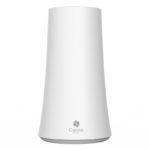By Brad Canham
New long-range Bluetooth and Bluetooth edge gateways will continue to provide a competitive advantage within the IoT predictive maintenance market more broadly, and for IoT system integrators specifically.
As may be expected of a fast growing market, the predictive maintenance market is attracting “several new players” to the global predictive maintenance market “owing to the high growth potential and absence of entry barriers,” according to a 2016 Persistence Market Research report.
Moreover, the new entrants to the IoT predictive maintenance market are described as “introducing low-cost solutions” resulting in the competitive responses: 1) to” lower the prices” by incumbent vendors, and 2) to “offer add-on services.”
Enterprise Bluetooth IoT: Competitive advantages
As a low-cost wireless IoT protocol with long battery life, BLE provides for monitoring in difficult to reach, previously unmonitored scenarios. Bluetooth IoT system integrators will compete by deploying much more monitoring, in unique use cases, at a lower cost, than competitive systems.
For example, unlike the cellular protocol, BLE sensors and connectivity cross nation boundaries without the added costs of national provider-specific sensors and monthly data fees. Also, BLE data gathered by a IoT Bluetooth gateway or router, connects to existing infrastructure -rather than requiring a new connectivity layer overlay – via backhaul using ethernet, Wi-fi, or even cellular (if necessary), further reducing costs of an Bluetooth IoT predictive maintenance system.
Moreover, until recently Bluetooth was constrained by short-distance and one-to-one connectivity. Now, enterprise IoT Bluetooth gateways, provide connectivity up to 1000 feet and connectivity in one-to-several hundred. As a result, this increased “connection density” results in a significant higher return-on-investment (ROI) for BLE to Bluetooth IoT gateways employed in Bluetooth IoT predictive maintenance systems. Additionally, Bluetooth IOT gateways provide cloud-based bi-directional control of BLE sensors, via platforms and applications. In turn, the low-cost delivery of enterprise Bluetooth IoT data to the cloud provides big data analysis required for IoT predictive maintenance.
IoT Predictive Maintenance: Environmental factors
Environmental factors are an important factor when deploying Bluetooth IoT predictive maintenance gateways in an industrial environment, and where dust and water is prevalent – whether indoor or outdoor.
The Cassia X1000 Enterprise Bluetooth router  is an example of an Bluetooth IoT predictive maintenance gateway which is designed with the environment in mind.
is an example of an Bluetooth IoT predictive maintenance gateway which is designed with the environment in mind.
The Cassia X1000 gateways are designed with a contained outer cap designed to withstand hostile environmental conditions. Industrial predictive maintenance environments which include “dirty” conditions or require indoor and outdoor system, may be well suited to a predictive maintenance gateway with this design.
Bluetooth IoT Edge Gateways: Predictive Maintenance value-add
As noted in the 2016 Persistence Market Research report, as the IIoT predictive maintenance market rapidly matures, simple connectivity solutions are destined to lose market share to low-cost and value-add systems. Therefore, a predictive maintenance system with third-party application support on the gateway, or “edge” capabilities is a competitive advantage. The E1000 Bluetooth Edge Router is an example of a IoT Bluetooth router with the capability of running third-party  applications locally. Moreover, it is likely that predictive maintenance IoT edge capability, built into the early-stage deployment of a system, will evolve with the end user.
applications locally. Moreover, it is likely that predictive maintenance IoT edge capability, built into the early-stage deployment of a system, will evolve with the end user.
As noted in the Deepwater Horizon example, high capacity production systems and machines quickly experience cascading bottlenecks and catastrophic downtime failures. It also results in more self-sufficiency and efficient data processing occurring in parallel, machine-to-machine learning, as well as faster feedback, alert triggers, responses, and fixes. Moreover, the bi-directional capability of a self-sufficient edge gateway reduces the risk of failure if a network issue occurs.
A Bluetooth low-energy (BLE) system allows for a sensor environment in which a predictive maintenance monitoring system can be locally powered for years, rather than days, or hours. In addition, local analytics can help to detect a security issue if abnormal node or network behavior is detected. Especially valuable are edge-enabled local insights based on contextual circumstances (ex. weather data). For example, a remotely monitored orchard, with no network access, may report in real-time that several cloudy days have had an impact on the solar-power batteries used to power a watering system.
Processing machine health data at the edge relieves the network burden of data. Moreover, processing data with edge algorithms at the local level substantially reduces the network costs of data “noise” in the network freeing up bandwidth for cloud enabled services using the “batch” data associated with larger data sets.







